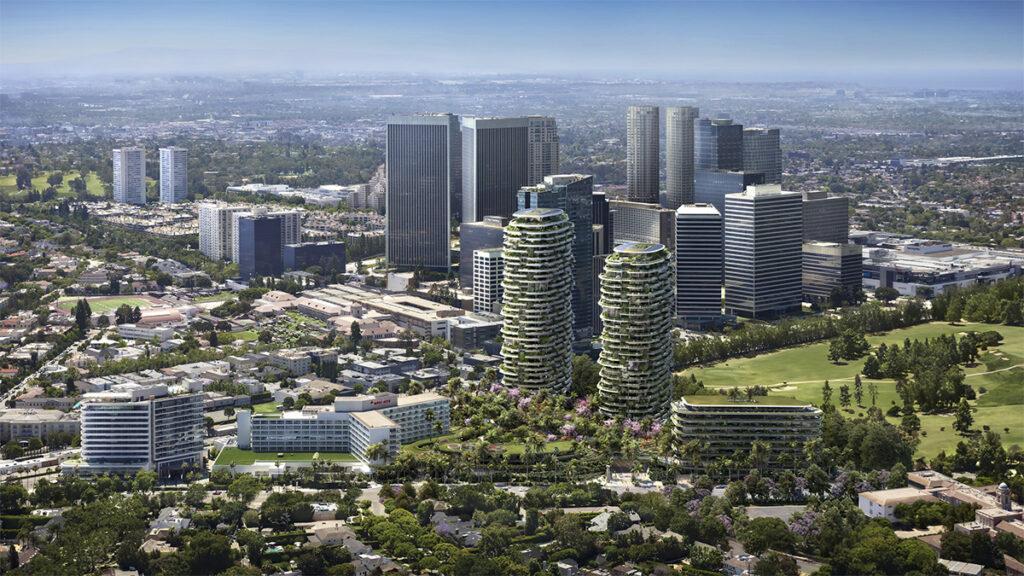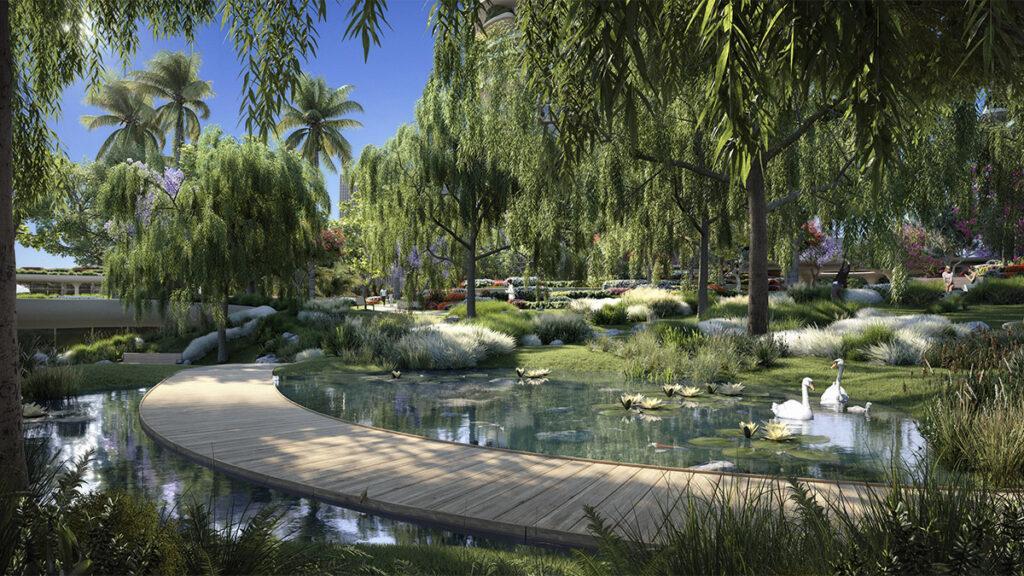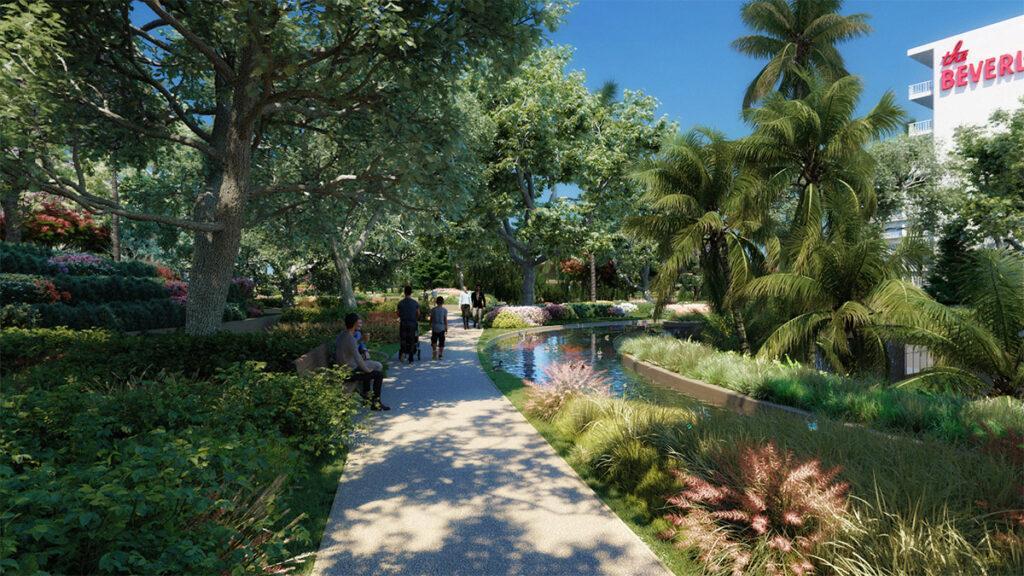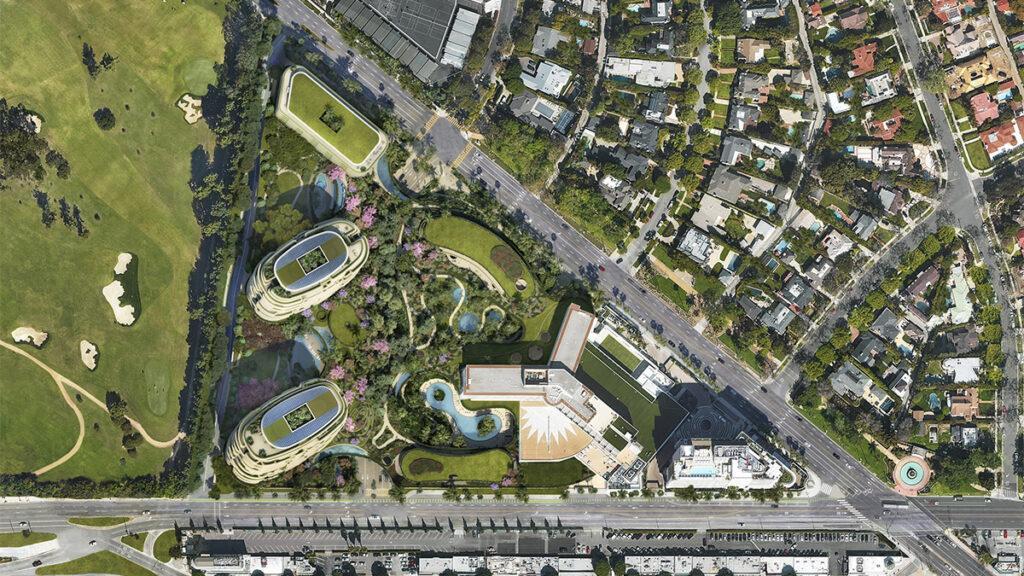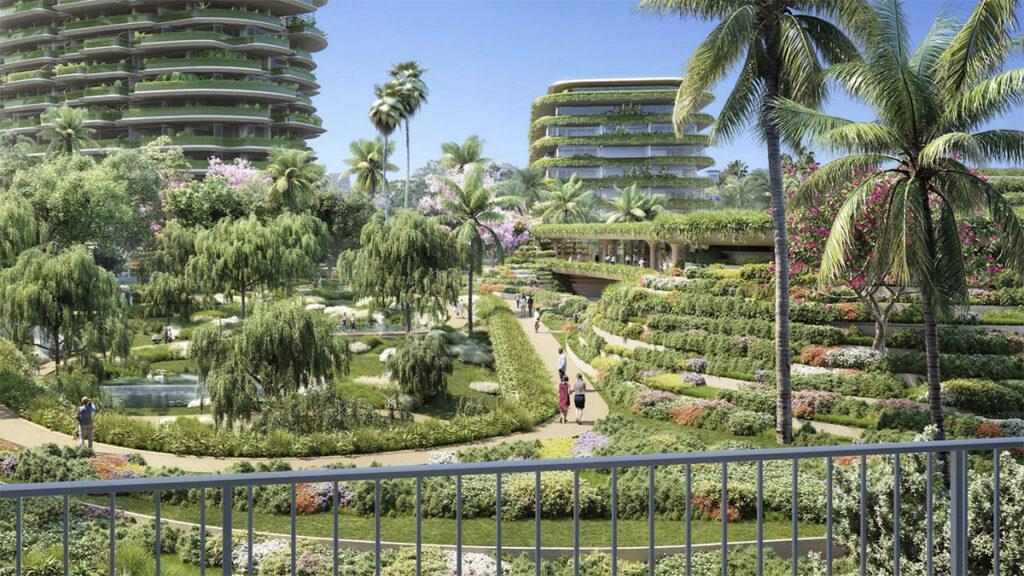The green towers of Beverly Hills
The district where film stars like to congregate is now the setting for one of the biggest environmental projects in the USA: “One Beverly Hills” is creating green towers and gardens alongside legendary VIP hotels. A green “triangle” with master plan by Foster + Partners will offer public zones and – naturally – new luxury.
At first glance, the designs seem reminiscent of Stefano Boeri’s famous “Vertical Forest” high-rises in Milan or his project “Smart Forest City Cancun”. There are also similarities with Vincent Callebaut’s concept “Paris 2050” and the fascinating “Rainbow Tree”. However, can it really be true that the same kind of visionary project is planned for Los Angeles County? Right next to the “Beverly Hilton”, legendary since the 1950s and where film stars receive their Golden Globes every year? Yes, it is really true. What’s more, the project “One Beverly Hills” has the potential to become a star in its own right. After all, it is creating green public space and new luxury as well. And it is also among the largest, most ambitious environmental projects in the USA.
Sustainability on a grand scale
Covering around 17.5 acres, the area of land is situated between Wilshire and Santa Monica Boulevard. It is like a sophisticated slice of cake and is intended to surpass California’s sustainability goals, which are already ambitious. The master plan for the new project was drawn up by renowned office Foster + Partners, with Gensler as the executive architects. Studio RIOS from Los Angeles is ideally equipped with the regional knowledge necessary for the landscape planning. Last but not least, the Alagem Capital Group and Cain International are the project developers.
“One Beverly Hills” is designed to add a striking, versatile mixed-use resort to world-famous Beverly Hills. Its grounds will combine several plots of land that border on two VIP favourites there: the “Waldorf Astoria“ and “Beverly Hilton”. Specifically, the new project will enhance the area around three ecologically sustainable residential towers. Greened all over, they will be the tallest structures in Beverly Hills: the 32-storey “Santa Monica Residences Tower” will top out at 125 metres, and the 28-storey “Garden Residences” will reach 112.
Old splendour, newly integrated
A third, ten-storey building will accommodate a luxury hotel with 42 suites, restaurant and 37 owner-occupied apartments. And eight hectares of botanical gardens will provide the perfect green space as its surroundings. Old splendour will also be given a new shine: the iconic “Beverly Hilton” designed by Welton Becket is set to receive a new lobby. The entrance, ballroom and pool will be redesigned, with 36 cabana rooms added. Plus a modern conference centre with welcoming outdoor breakout areas.
“One Beverly Hills” will seamlessly integrate the existing buildings into the beautiful, green triangle as well, including the “Waldorf Astoria” hotel.
The two spectacular residential towers are not only expected to offer residents a spectacular view of the Pacific and the mountains. Their lush green facades are also intended to merge “One Beverly Hills” visually with the neighbouring “Los Angeles Country Club”. Displaying curving, soft shapes and outsized balconies, the high-rises will blend into their surroundings pleasantly and inconspicuously.
Symbolic “gateway”
“The design of One Beverly Hills is sensitive to the history and rich traditions of California. Set within lush greenery, the organic architecture and the landscape come together to form a symbolic gateway that is very much of its place,” explains Foster + Partners studio head David Summerfield.
Green heart for Beverly Hills
The true heart of the master plan is the botanical gardens, though. Foster + Partners have designed a raised platform for this sustainable oasis, built on the west side towards the Beverly Hilton. More than 40 types of trees and 250 plant species from 13 different botanical regions of California are expected to thrive here.
Environmentally friendly oasis
The concept aims to create an environmentally friendly zone where people can relax and spend time. Around half of the green space will be open to the general public. Sculptures, water features, shaded seating areas, around three kilometres of footpaths and other amenities are also planned.
The entire gardens of “One Beverly Hills” will be watered by an extensive greywater system. Rainwater and recycled greywater will be used to achieve 100% sustainability.
Operations will be monitored by a communal nature conservation organization. This conservancy will be made up of community leaders and school directors, together with representatives from the hotels and residents. It will also organize on-site educational programming. Most importantly, “One Beverly Hills” is designed to become a benchmark of ecological sustainability. And so it will combine modern technologies to drastically reduce emissions and energy consumption.
Climate protection as the top priority
The project is equipped with a photovoltaic system, centralized battery and chilled water thermal energy storage system. Environmental protection is key to the development of the new buildings as well: recycled, low-carbon and low-emission materials are used for construction.
The grounds are designed to allow mobility on foot or bicycle. Still, the developers have not forgotten that life in Los Angeles and its surrounding area is almost unimaginable without a car. As climate protection is the prime focus, though, there are multiple charging stations for e-vehicles in the underground parking garage.
“The design is all about working with nature, with buildings set within the landscape and opening up the interior to the outside. The result is a sustainable ensemble that is in tune with its surroundings,” outlines Armstrong Yakubu, senior partner at Foster + Partners.
Star architect Norman Foster, founder and head of the office, refers to the history of the region: “In its beginnings, Beverly Hills was agricultural flat land – a green oasis that fed a growing urbanity. A century later, we have seized on this inspiration to create an organic architecture that merges with landscape.”
For the benefit of the whole city
An important goal is to allow this project to become a resource for the city as a whole. According to Foster, the richness of Californian culture owes much to its diversity of influences. The architect sees this as being inseparably linked to the urgent need for sustainability: “We welcome the opportunity to create a holistic masterplan based on a green approach across the entire site.” The opening of the visionary project “One Beverly Hills” is scheduled for 2026.
Text: Elisabeth Schneyder
Translation: Rosemary Bridger-Lippe
Renderings: DBOX / Foster + Partners
